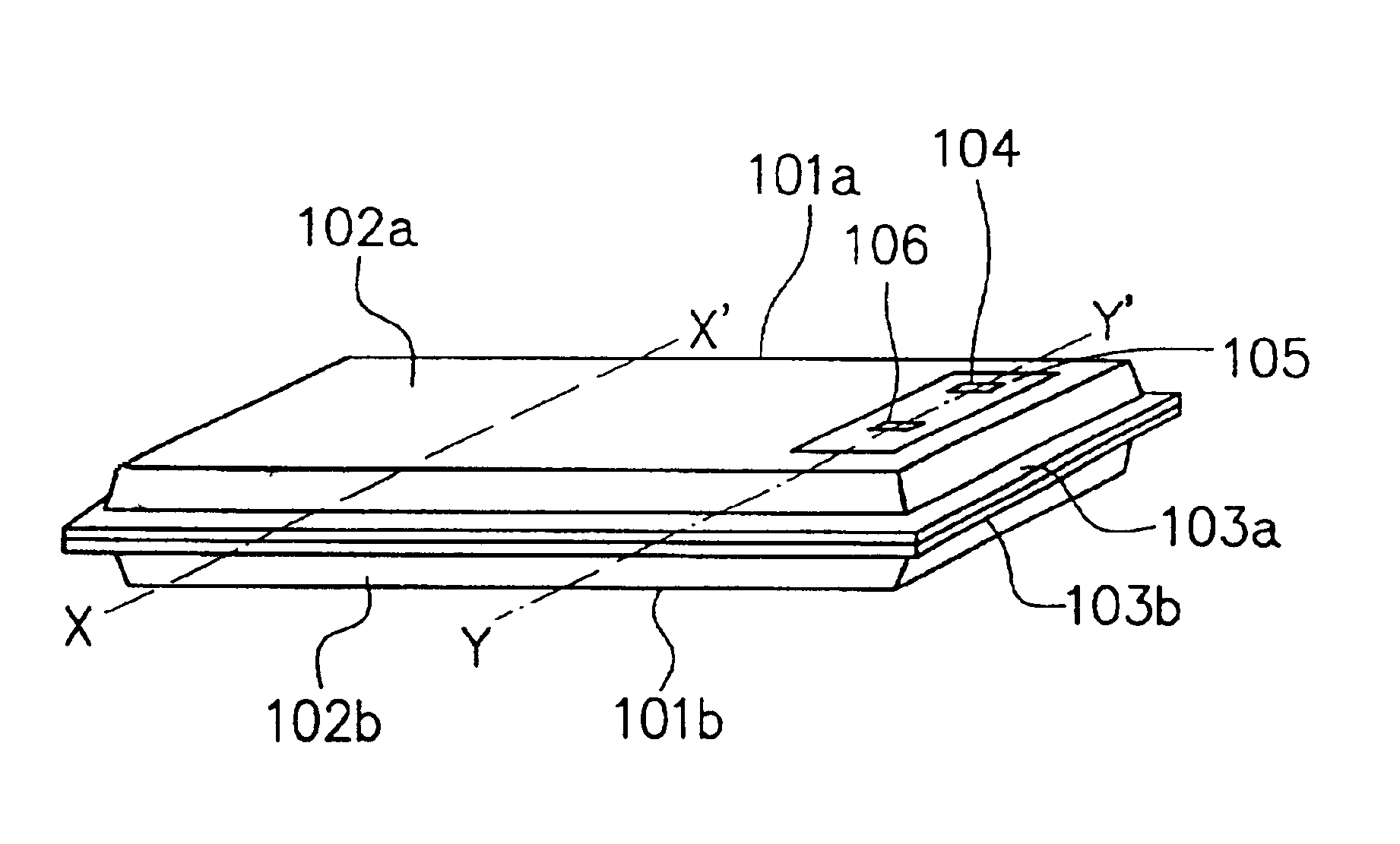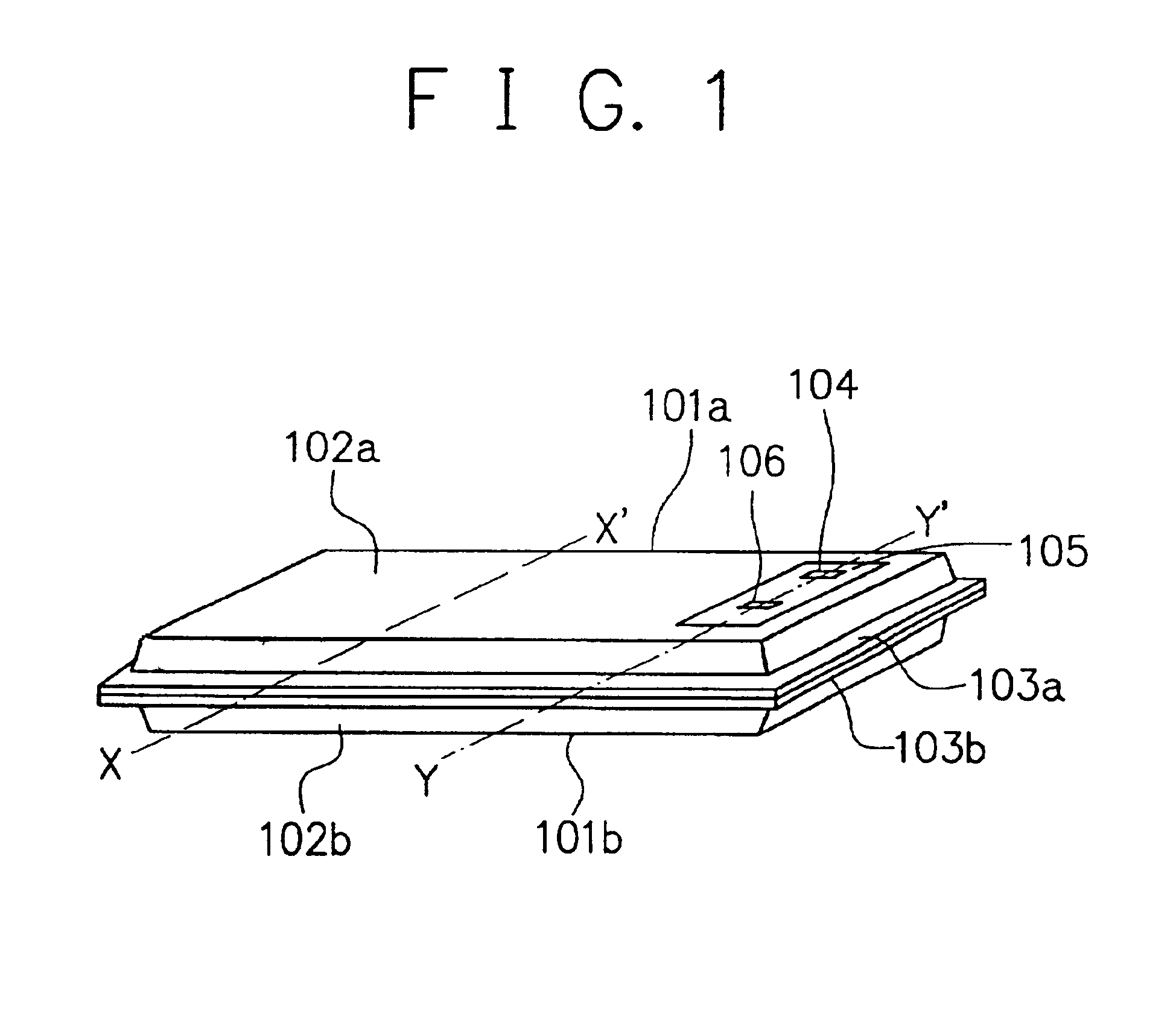Rechargeable lithium battery
a rechargeable lithium battery and lithium battery technology, applied in the direction of cell components, flat cell grouping, sustainable manufacturing/processing, etc., can solve the problems of inability to work a terminal cap and an insulating mold, increase the production cost of a prismatic rechargeable battery, and inability to meet the requirements of the market, etc., to prolong the charging and discharging cycle, prolong the cycle life, and prolong the cycle li
- Summary
- Abstract
- Description
- Claims
- Application Information
AI Technical Summary
Benefits of technology
Problems solved by technology
Method used
Image
Examples
example 1
[0115]In this example, there was prepared a thin type rechargeable lithium battery having such configuration as shown in FIGS. 1 to 4 in the following manner.
1. Preparation of Cathode:
[0116]90 parts by weight of LiCoO2 as a cathode active material, 5 parts by weight of natural graphite as an electrically conductive auxiliary, and 5 parts by weight of polyvinylidene fluoride as a binder were mixed to obtain a mixture. The mixture was mixed with 50 parts by weight of N-methyl-2-pyrrolidone as a solvent to obtain a paste having a viscosity of 3000 cps. The past was applied onto opposite sides of an aluminum foil having a thickness of 20 μm as a collector, followed by subjecting to drying thereby to form a coat layer on each of the opposite sides of the aluminum foil.
[0117]The resultant obtained in the above was subjected to pressing to obtain an element having a thickness of 200 μm which comprises the aluminum foil sandwiched between the two layers each as a cathode active material lay...
example 2
[0130]The procedures of Example 1 were repeated, except that the preparation of the anode in the step 2 in Example 1 was conducted as will be described below, to obtain five thin type rechargeable lithium batteries.
Preparation of Anode:
[0131]60 parts by weight of a powdery tin material having an average particle size of 3 μm as an anode active material and 5 parts by weight of carboxymethyl cellulose as a binder were mixed to obtain a mixture. The mixture was mixed with 35 parts by weight of deionized water as a solvent to obtain a paste having a viscosity of 2000 cps. The past was applied onto opposite sides of a copper foil having a thickness of 12 μm as a collector, followed by subjecting to drying thereby to form a coat layer on each of the opposite sides of the aluminum foil. The resultant obtained was subjected to pressing to obtain an element having a thickness of 180 μm which comprises the copper foil sandwiched between the two layers each as an anode active material layer. ...
example 3
[0132]The procedures of Example 1 were repeated, except that without using the separators and the electrolyte solution, a solidified electrolyte material layer was formed on the surface of each cathode and also on the surface of each anode as will be described below, to obtain five thin type rechargeable lithium batteries.
[0133]On the opposite surfaces of each of six cathodes having a size of 52 mm×70 mm prepared in the same manner as in the step 1 in Example 1 and also on the opposite surfaces of each of seven anodes having a size of 52 mm×70 mm prepared in the same manner as in the step 2 in Example 1, a coating liquid obtained by mixing 70 parts by weight of methoxypolyethylene glycol monoacrylate and 30 parts by weight of polyethylene glycol dimetacrylate to obtain a mixture and mixing said mixture with 400 parts by weight of an electrolyte solution obtained by dissolving 1 M (mol / liter) of lithium hexafluorophosphate dissolved in 1 liter of a mixed solvent obtained by mixing et...
PUM
| Property | Measurement | Unit |
|---|---|---|
| width | aaaaa | aaaaa |
| thickness | aaaaa | aaaaa |
| thickness | aaaaa | aaaaa |
Abstract
Description
Claims
Application Information
 Login to View More
Login to View More - R&D
- Intellectual Property
- Life Sciences
- Materials
- Tech Scout
- Unparalleled Data Quality
- Higher Quality Content
- 60% Fewer Hallucinations
Browse by: Latest US Patents, China's latest patents, Technical Efficacy Thesaurus, Application Domain, Technology Topic, Popular Technical Reports.
© 2025 PatSnap. All rights reserved.Legal|Privacy policy|Modern Slavery Act Transparency Statement|Sitemap|About US| Contact US: help@patsnap.com



